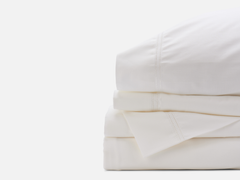When we think about going to bed at night, our first thought is to usually crawl under the covers, snug and warm. But the warmth that is so comforting to some of us is the reason others of us can’t get to sleep at night. If this is you, don’t despair. We have tips for hot sleepers, and knowing how your sheets can impact your sleep is the first step.
What Does It Mean To Be a Hot Sleeper?
You wake up in the middle of the night to find yourself uncomfortable and sticky with sweat. You toss, you turn, you throw off blankets, but you just can’t get back to sleep. Most of us have experienced this at least once on a particularly balmy summer night when the air conditioning went out. But for hot sleepers, this is the reality even when it isn’t too hot out.
There are multiple reasons why people get hot at night, including:
- High room temperature
- Stress
- Hormonal imbalances (such as those that occur during puberty, pregnancy, and menopause)
- Exercise right before bed
- Neurological disorders
- Illness or medications
Your bedding is also a common reason you may get warm at night. While it’s easy to blame cumbersome comforters or flannel-lined quilts, our sheets are often the main cause of summery sleeping woes.
How Bedsheets Impact Your Sleep as a Hot Sleeper
We don’t just tuck ourselves under sheets at night because they’re comfortable. When we fall asleep, our body temperature drops by a few degrees. Our bedsheets help trap the heat as it escapes us, keeping us warm. That’s why we’ll often wake up shivering if our blanket falls off in the middle of the night.
We want to keep some heat close to us to keep us warm at night, but some sheets are so dense that they trap too much heat. Any moisture from our skin also gets trapped, raising the humidity with it. That’s when the temperature rises, and we wake up sweaty and uncomfortable.
Tips for Choosing Sheets for Hot Sleepers
When it comes to being a hot sleeper, the trick is to find bedsheets that trap heat while also being breathable.
Materials
Some materials are more breathable than others. Fleece and polyester, for instance, are known to trap heat next to the body for a warmer night’s sleep. However, a material can be breathable but not moisture-wicking, leaving you humid and hot. If you’re a hot sleeper, look for sheets made up of materials that are both breathable and moisture-wicking or absorbent, such as:
- Cotton
- Linen
- Bamboo
- Merino wool
- Tencel or lyocell
- Hemp
While all these materials have their benefits, pure cotton bedding is often more cost-effective and comes in a variety of weaves, allowing you to pick the perfect sheet for you.
Thread Count
When it comes to bedsheets, a lot of time is spent discussing thread count without really understanding what it means. Thread count discusses how many threads are woven into a single square inch of fabric.
A lot of people hear this and assume that a higher thread count must be better. However, all those extra threads per square inch create a less breathable fabric and a hotter night’s sleep. For hot sleepers, the lower the thread count, the better, coupled with high-quality materials.
Weave
The weave is just as important as thread count when it comes to determining the breathability of your bedsheets, if not more so. There are several types of weaves you will likely encounter when it comes to natural-fiber bedsheets. Some of the more common ones include:
- Flannel
- Sateen
- Twill
- Percale
Flannel and sateen are the heavier of the weaves, which is why you will often see people use them in the winter. Twill is lighter, but the texture is often rough and uncomfortable to the touch. The percale weave is particularly good for hot sleepers because it combines a light, crisp weave with a smooth finish.
Color
If you’ve ever walked outside barefoot on a hot summer day, you know there is a difference between walking on a pale-colored sidewalk and dark-colored pavement. The sidewalk is warm but not uncomfortable, while the blacktop feels like walking on hot coals. That’s because dark colors absorb heat much more quickly than light colors do.
This becomes important if your bedroom gets any sunlight during the day. If you’ve picked dark color sheets, they may retain a little heat by nighttime. Crisp, white sheets will typically remain much cooler in the sun. Otherwise, take the time to close your drapes during the day to keep your bedroom dim and cool.
Tips for Keeping Bedsheets Cool
The type of sheets you have is the main factor in keeping you cooler at night as a hot sleeper. But there are some extra things we can do to help the process of keeping our bedsheets cooler.
Wash Your Sheets
It always feels nice to slip under some fresh, clean sheets at the end of the day. And taking the time to wash your sheets regularly may also help keep your sheets cool as well. If you have spent several nights sweating under the covers, all that oil and moisture accumulates. This can lead to more humidity and trapped heat. Washing them once or twice a week will keep them fresh.
Tip
Our first instinct is often to wash our sheets at high temperatures to kill germs. But high heat can damage bedsheets after a while, especially if they’re cotton. Washing them at cooler temperatures will help preserve them and keep the sheets cooler.
Shower Before Bed
Showering before bed is already a great way to stay cool at night by lowering your body temperature before you even hit the sheets. But washing before bed helps benefit our sheets as well. Washing keeps the dirt, oil, and sweat on our skin from hitting our bedsheets. This will keep the sheets clean and lower the humidity levels under the covers.
Seasonal Bedding
Since sheets are right next to your skin, they tend to be the primary culprit for hot nights. But that doesn’t mean that other bedding doesn’t have a role to play. That sturdy heirloom quilt that keeps you cozy all winter may keep you far too warm during the summer. If you haven’t already, it’s a good idea to switch to lighter outer bedding like a duvet during the summer.









